Table of Contents
The objective of the work reported here was to examine, analyze and evaluate the safety hazards which affect mining dredge workers. The safety hazard consideration involved design and environmental hazards as well as those related to dredge operation and maintenance. It included shore-based equipment which supports the dredge or which is in the production sequence immediately following, and regularly interacting with, the actual dredging.
The primary method of acquiring safety hazard information was direct observation of active dredge operations in several geographic areas. Many types of dredges, engaged in extraction of several kinds of minerals, were observed. Visits were made to representative dredge manufacturers to discuss safety from their perspective. The preparation for the field work included reviewing the available literature dealing with safety, examining Mine Safety and Health Administration (MSHA) data on mining dredge accidents and injuries for a period of about five years, and contacting dredging consultants and dredging associations to obtain their general views on safety matters.
The report is organized so that the hazards which were observed, or identified in other ways, are discussed first (Section 2.0). Immediately following the hazards discussion are the recommended Bureau of Mines research projects which would address the hazards and influence the general improvement of safety in the dredge mining industry (Section 3.0). The last four sections provide details about the characteristics of the dredges observed (Section 4.0); summaries of the discussions with dredge manufacturers, consultants and others from whom information was obtained (Section 5.0); the results of the analyses of MSHA data about mining dredge operation fatal and other injury accidents (Section 6.0); and a summary of the literature review (Section 7.0).
Executive Summary
In the years 1973 through 1979, 48 persons died as a result of accidents related to dredge mining operations in the United States. Approximately 63% (or 30) of those who died were drowned. Nine were killed in fixed machinery accidents; five fatalities were related to mobile machinery accidents; and four persons were electrocuted. A significant percentage of all lost-time injuries in the sand and gravel industry occurs on dredge operations. (In 1974, for example, dredge operations accounted for nearly 25% of the total in the industry and 1974 was not an unusual year in this respect.)
After examination of MSHA data and a review of literature on dredge safety, a series of field observation trips was made. Thirty-one dredges were visited to observe design features and safety problems related to dredge operation and maintenance. The products extracted by the mining dredges included sand and gravel, gold, phosphate, ilmenite, and coal. Ten states were represented in the sample of dredge operations observed. Eighteen of the dredges were “manufactured.” The others were built by local machine shops or by their owners. The dredges represented a wide range of sizes, digging methods and production. The digging methods included suction, cutterhead-suction, bucket wheel, bucket line, and clamshell. The annual material movement ranged from 45,000 tons to more than 11 million tons.
One of the largest dredges observed is shown in Figure 1-1. A much smaller dredge of an entirely different type is shown in Figure 1-2.
The dredge in Figure 1-1 was built 40 years ago. It is a bucketline dredge used to mine gold in Alaska. All of the processing machinery is on board. The thaw field in the background is part of the preparation for the actual dredging. Thawing of the permafrost usually must precede the dredging by two to three years. The dredge in Figure 1-2 is a dragline with a clamshell, mounted on a barge. It is representative of a type used in some sand and gravel mining operations, although the one shown was doing lake maintenance in Ohio when it was visited.
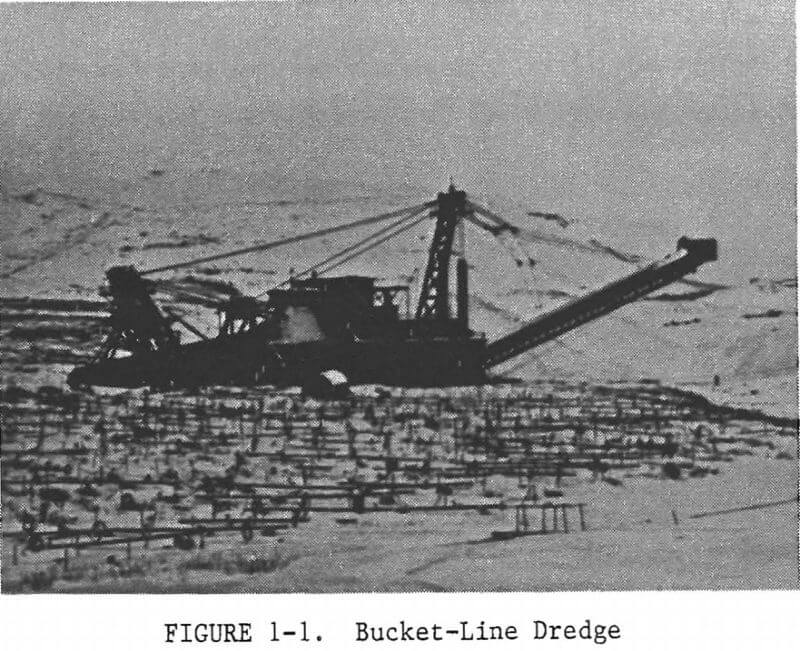
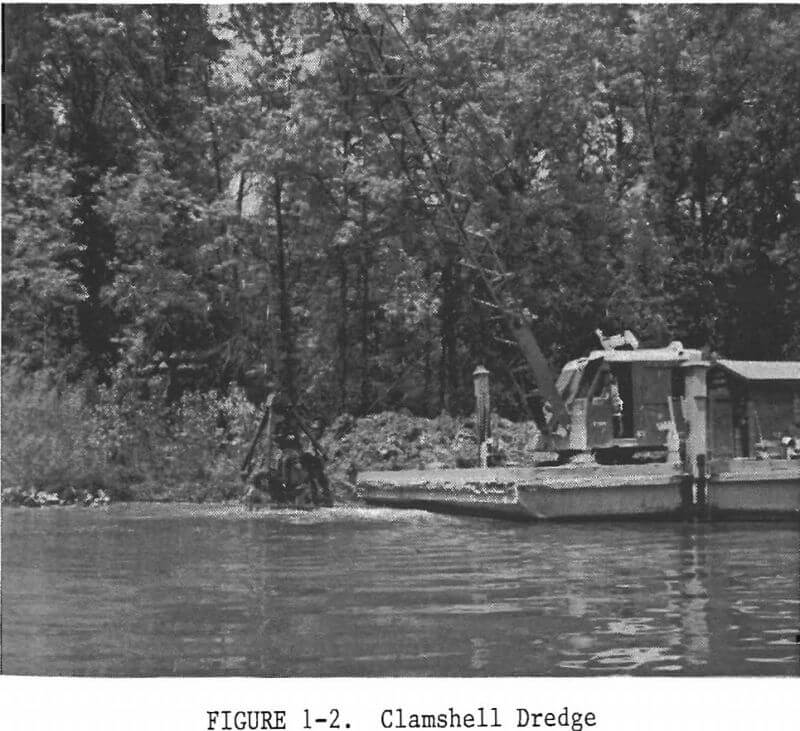
The hazards are described in Section 2.0. They include falls into the water; slips and falls on the dredge; electrical; mechanical; fire; on-shore, hazards; and some hazards unique to a small proportion of the dredge mining fleet, such as PCB contamination of the bilges and hydrogen sulfide gas (H2S) release.
The recommended Bureau of Mines research to improve dredge mining safety emphasizes the need for development of an improved personal flotation device (PFD) and the development of means to provide safety information to dredge owners and operators. The most surprising finding from the field work was the lack of understanding of, and therefore concern about, hazards extant at many dredge operations. A small proportion of the dredge operations did an excellent job in safety and loss control management. Unfortunately, it appeared that at the majority of the operations neither the managers nor the workers paid much attention to these matters. However, virtually all of the operations became interested in new safety equipment, safer work practices, and better training techniques during the discussions. They invariably expressed a desire to have more authoritative information, and in a form which would be convenient for management use.
Hazards in Mining Dredge Operations
The principal hazards observed during visits to dredge operations, reported by manufacturers, consultants and others, discussed in literature about dredge operations, or reflected in MSHA injury data, are discussed in the subsections below. The order in which they are discussed is the order of their estimated importance.
Falls into the Water
Falls into the water from the dredge, barges, work boats, pipelines, and shore are common. Most, fortunately, do not result in any injury that is serious enough to require reporting. However, drowning after falls into the water accounts for a very large proportion of the fatal accidents which occur in dredge mining operations (see Section 6.0 for data and accident descriptions).
Like most safety problems, this one should be dealt with, first, through measures to prevent the accident, and second, through measures to prevent injury if the accident should occur. Jobs should be designed, and tools, training, and supervision provided, so that the risk of falling into the water is very small. Protective equipment and water survival training should be provided, and its use practiced, so that the probability of surviving a fall into the water without injury is greatly increased.
None of the dredge operations visited had taken all of the measures required for maximum job safety, but several had many of the measures in effect. Figure 2-1 illustrates such an operation. There is an adequate railing around the deck. The deck itself is clean and uncluttered. The worker is wearing a personal flotation device (PFD) and other lifesaving equipment is readily available for use and in good condition. This operation did not provide, or require, water survival training and the deck surfaces were not treated to reduce slips and falls, although generally
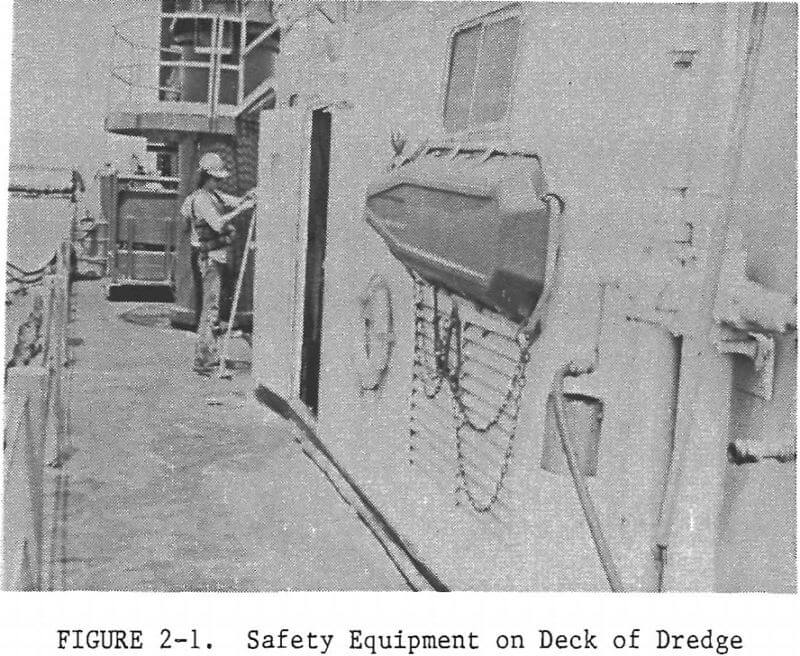
adequate for the Florida environment in which the dredge was working. Safety rules were published and enforced.
Deck railings are a fundamental safety need, but not sufficient alone to protect dredge workers from falls into the water. A railing strong enough and high enough to restrain workers who lose balance on a pitching deck is necessary. Such a railing is shown in Figure 2-2.
Removable sections may be desirable in some operations to make loading onto decks from other vessels safer. However, the task of transferring materials is a task in which the risk of falling into the water is greatest. Special safety procedures for the task are important and a worker engaged in the task should not work alone. Removable sections should be immediately replaced when the materials transfer has been completed. Open sections are a particular hazard in poor weather and at night. Sometimes the hazard is increased by the nature of materials on the deck opposite the open section. This condition is illustrated in Figure 2-3.
Several of the dredges visited had no deck railings at all. Those dredges also had cluttered decks which increase the probability that a worker may trip and fall into the water. Dredges with these conditions often do
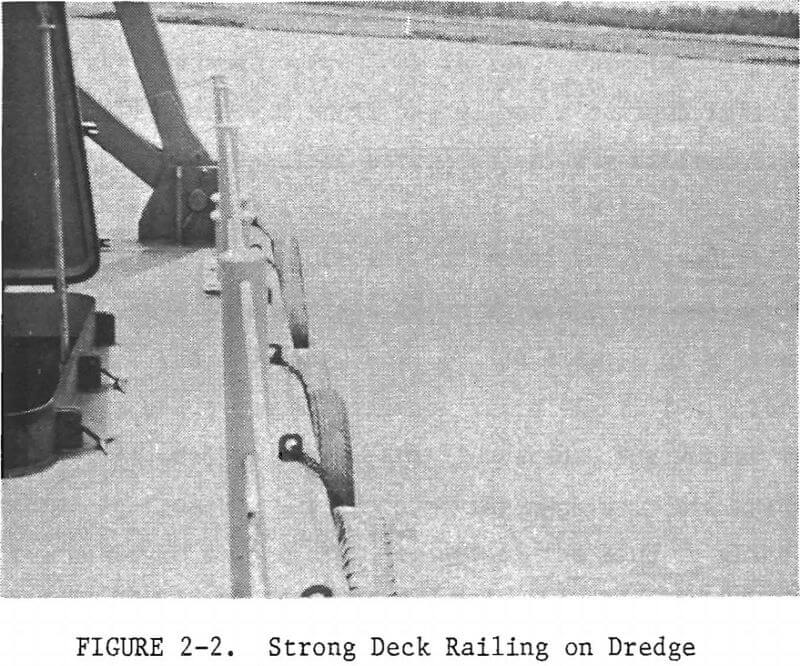
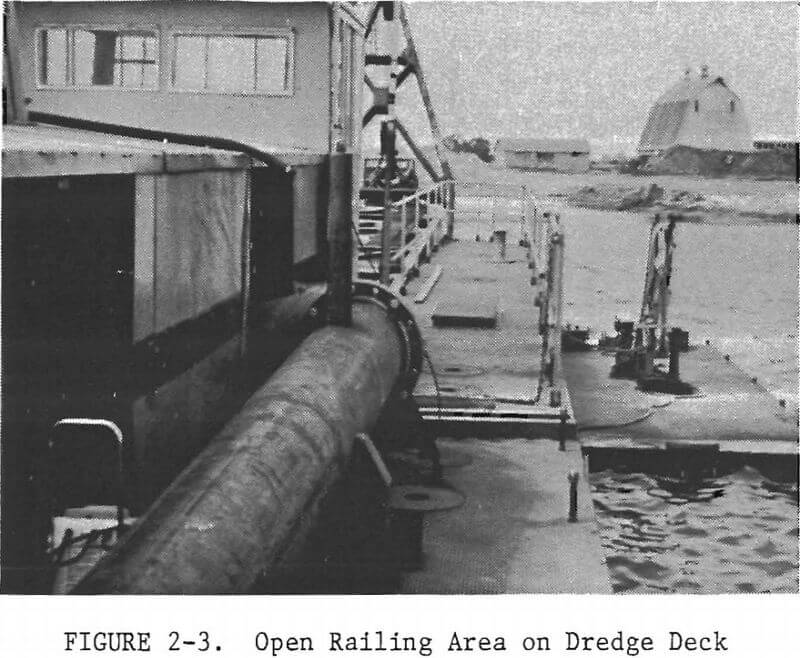
not enforce the wearing of PFDs. Clearly the safety consciousness of management and workers at such operations is low. Unfortunately, the conditions are not usually improved until and unless a serious injury occurs and federal or state mine inspectors become especially diligent in their duties. At three of the dredges visited which had better than average safety practices, the management representative explained the present safety status by including statements such as “right after we had a serious accident, we” and “soon after the drowning, we” An example of a dredge operation with few safety practices in evidence is in Figure 2-4. There is no deck railing on the dredge. Decks are cluttered. The worker is not wearing protective equipment. Guards on moving machinery are inadequate, etc. Figure 2-4 would be a good training aid of the kind in which the student is asked to “find six safety hazards in this picture.” (There are more than six.) Figure 2-5 is another dredge with no deck railings. Figure 2-6 is a close-up view of a section of deck on the same dredge. It shows that a deck railing was once welded to the deck. But now the railing is gone and a tripping hazard (the pipe bolted to the deck) has been added.
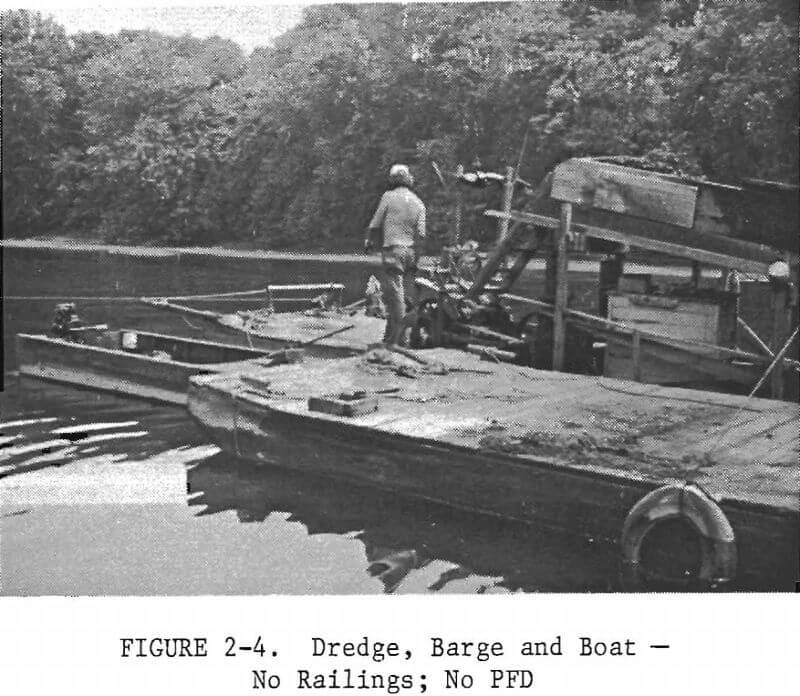
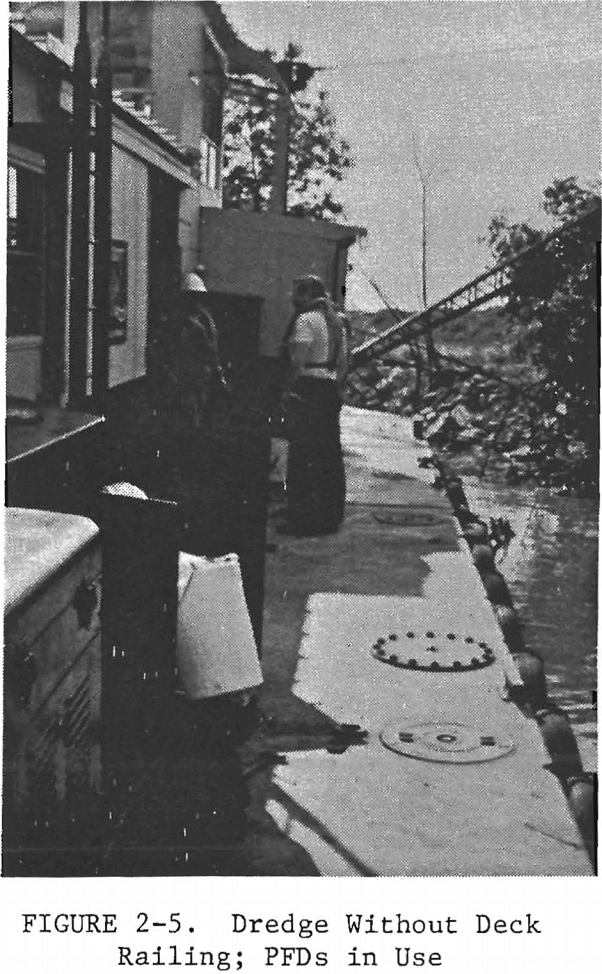
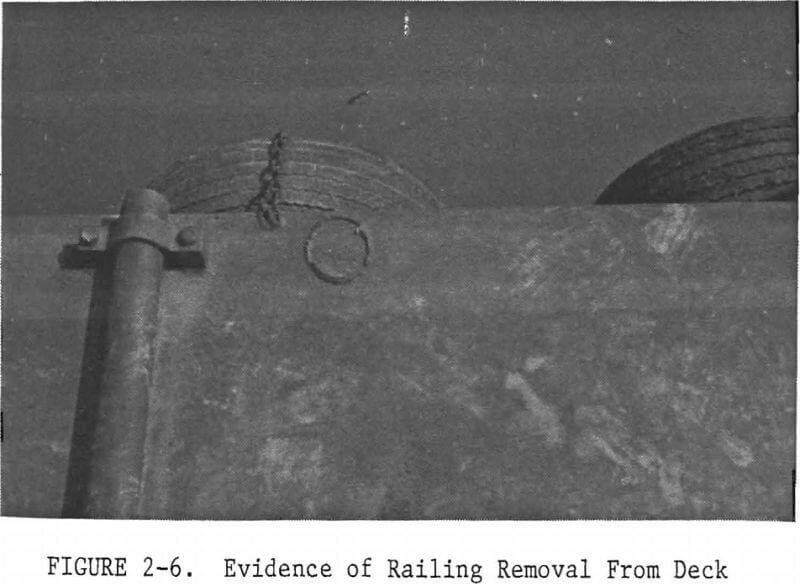
Several of the dredges observed operated with lines which moved the dredge digging mechanism in a sweeping pattern. When the digger would contact hard ground areas, stumps, or other underwater objects, the sweep of the dredge would be slowed or halted and pitching of the deck would occur. People standing near the edge of the deck would have to grab onto something to avoid falling. The most severe deck pitching observed was on a dredge which dug with a bucket wheel.
Railings along walkways are also an important countermeasure for accidental falls into the water. Some dredge operations have walkways which are the primary means of moving personnel and small materials from shore to dredge. Others have walkways as secondary means of shore to dredge access or for maintenance access to pipelines, conveyors, power lines or other equipment. Frequently the walkway serves several purposes and is constructed over, or along, the dredge-to-shore materials transport system. Figure 2-7 shows a walkway with a substantial, continuous railing. The walkway itself is wide and constructed of slip-reducing metal plates. Walkways of this quality were not common at the dredge operations visited. There were several operations at which people were observed walking on pipelines, or on pipeline buoys, where no walkway or railing existed. Figure 2-8 shows such a buoyed pipeline. Depending upon the spacing between buoys (or pontoons) and the weather conditions, walking the buoys is an activity of moderate to great danger. Walking the pipeline itself is always very hazardous.
Figure 2-9 shows a work boat moving from dredge to shore (a short distance in this case). The operator is standing, always more dangerous in terms of the falling overboard risk than sitting. Many of the dredge operations visited had only one boat for personnel movement. On dredges on which only one person works each shift, a very serious problem may occur if the dredge worker is disabled or if the boat is not available. During the field visits there were several cases mentioned in which the dredge worker, through illness or accident, becomes disabled and unable to transport himself to shore in the boat, and there was no other boat which persons on shore could use to reach him. There were also cases mentioned in which boat, taken to the dredge, was not secured. It drifted away, leaving person or persons on the dredge without a safe means to reach shore,
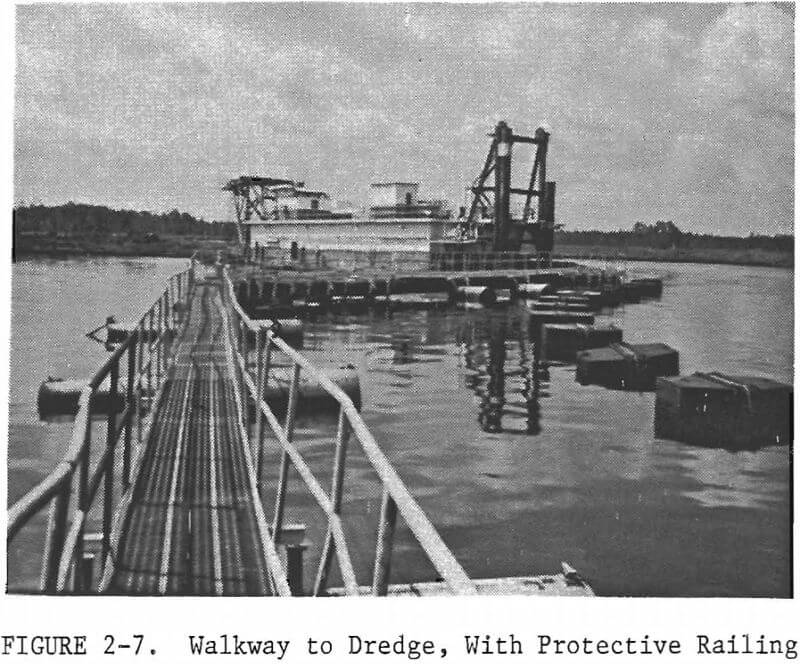
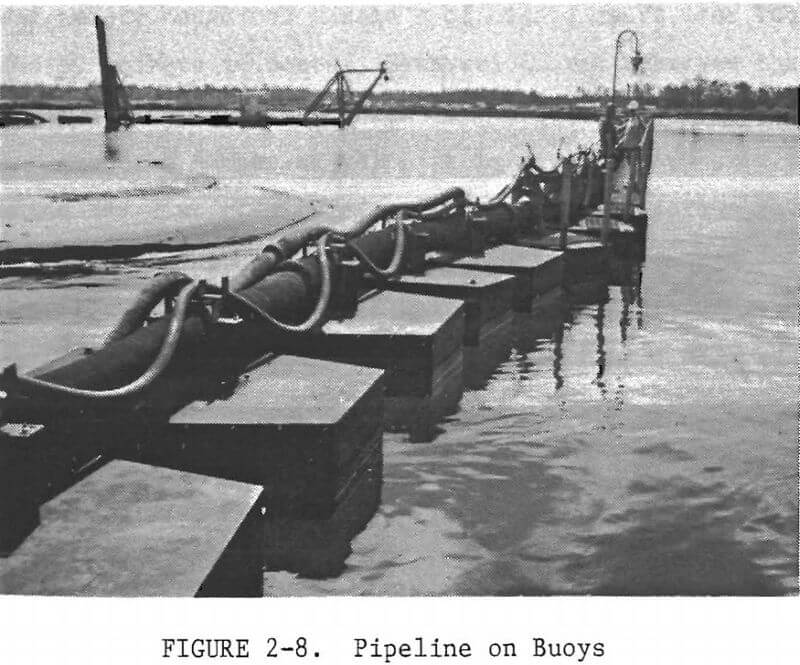
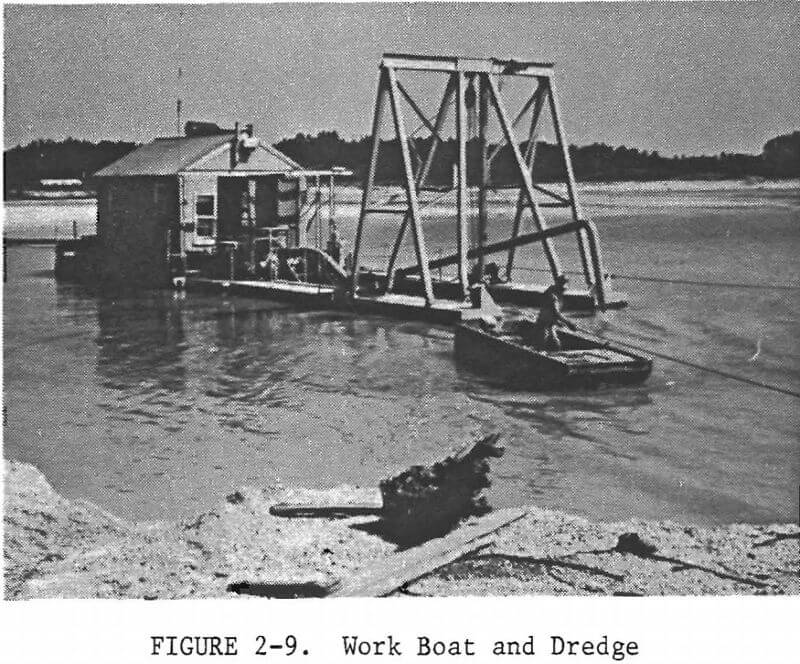
and the people on shore had no immediate way to provide assistance. One MSHA inspector with whom dredge safety problems were discussed expressed the view that all dredges must be required to have two boats, unless there is a dredge-to-shore walkway that can safely be used. The information from field visits made in this program certainly support this view.
The most safety conscious managers of dredge operations required the use of PFDs by workers in boats. However, it was observed that, of the dredges visited, the number at which such a requirement is enforced is much smaller than the number at which it is not. It appeared that, even among those which had a written rule, enforcement was rigorous in only a few. Figure 2-10 shows the kind of condition which was observed to be very common. There are two men in the work boat. Both are standing, using the dredge railing for support, Neither of them is wearing a PFD.
During at least six of the dredge operation visits mention was made of collisions by private recreational boats with the dredge or the dredge-to-shore materials transport system (pipeline, barge or conveyor). This problem is more common at operations which work on, or adjacent to, public waterways, but by no means restricted to those operations. For example,
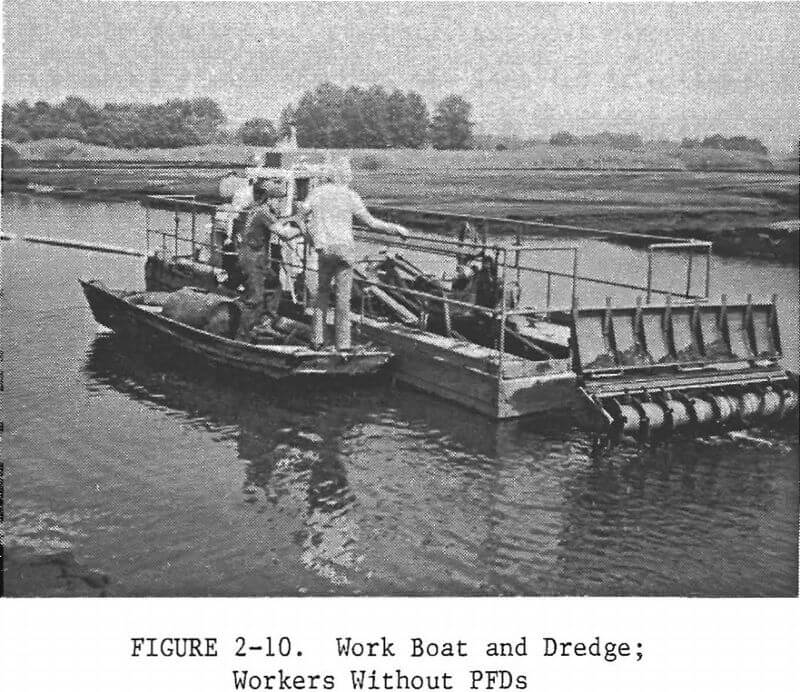
at one sand and gravel operation on a large, man-made, privately-owned lake several collisions involving trespassing motorboats were discussed. Several of the dredges displayed standard dredge navigational markings and running lights, but most did not. The principal hazard to dredge employees of a collision is being thrown overboard by movement of the dredge.
Storms and wave action may produce falls into the water or “swamping” of the dredge. On larger ponds and on rivers, most of the dredges move to shore whenever waves become large enough to be considered dangerous. Waves of less than 3 feet can swamp the smaller dredges. Wave action may also produce hull leaks. At two of the operations visited, the dredge had sunk through leaks and rough water action while operating. The dredges, like many, have a low freeboard. Leaks were not noticed by the operator until listing and sinking action had commenced.
Water surges in the pipeline produce falls into the water by pipeline workers or persons on a walkway attached to the pipeline. At least three dredge masters acknowledged that they had unintentionally “knocked a guy into the water” when the dredge pumps were started without warning. Some of the dredges visited used a horn or whistle signal to alert all workers that pumps were to be started (or stopped), but most depended upon the dredge master to make a visual check of the location of workers and a judgment about their safety. Apparently this check is not an effective counter- measure sometimes.
Pumping of sand and silt onto a dike or levee sometimes creates a danger of insufficient ground support for shore machines and workers. There have been instances of “quicksand action” in this material. A machine or operator “went into the soup.” Worker suffocation was a serious danger. In other instances, machines and workers have slid into the water.
In some dredging operations the bank being mined extends above the water level. The bank is undercut to cave into the water. This action may create a danger to the dredge and to men and machines working on the bank. During the field visits, several accidents involving bank caving were discussed. Some produced massive damage to the dredge digging mechanism and injury to those on board. Several resulted in drownings.
As noted above, many dredge operations do not have rules requiring the wearing of PFDs by persons working over the water and some of those which have such rules do not enforce them. Titles 30 CFR 55.15-20 and 56.15-20 state: “Mandatory. Life jackets or belts shall be worn where there is danger of falling into water.” There is a similar provision for surface coal operations in 30 CFR 77.1710(h). The words “where there is danger” are variously interpreted. Some dredge operation managers said that there is no danger for persons on the deck of a dredge which has deck railings. Several said that they had been advised by an MSHA inspector that such an interpretation of the standard was acceptable. Clearly, it was common practice on the majority of dredges visited not to wear PFDs on deck during the performance of most duties. At many dredge operations PFDs were not worn by any worker anywhere. (Note additional support for these observations in the accident summaries in Section 6.0.) At all except a few operations PFDs were “available,” but often they were not at hand for immediate use, and were not well-maintained. Figure 2-11 shows some “available” PFDs a dredge deck. Commonly the PFDs were not issued to workers who were
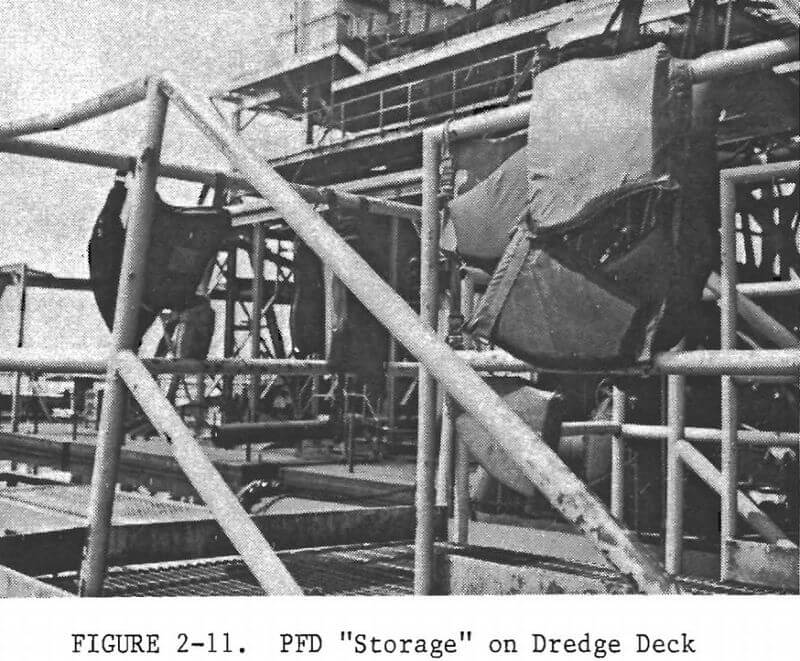
made personally responsible for their care and availability. Thus, PFDs could be “stored” in locations for many days without use or inspection. Figure 2-11 shows the “storage” of a PFD near a dredge work place. A PFD treated in this way can be damaged by grease, oil, and foot traffic. It is correct to state that the kind of PFD care shown in Figures 2-11 and 2-12 is typical, based on the sample of dredges visited. The kind of storage care shown in Figure 2-13 is the exception rather than the rule.
Many of the dredge workers with whom the use of PFDs was discussed said that they did not wear the PFDs regularly because:
- The PFDs provided were uncomfortable, particularly in hot, humid weather.
- The PFDs were a great hazard in many situations where they “caught on things” or “restricted movement” and caused loss of balance which could lead to falls.
- The PFDs get dirty quickly, making them undesirable to use.
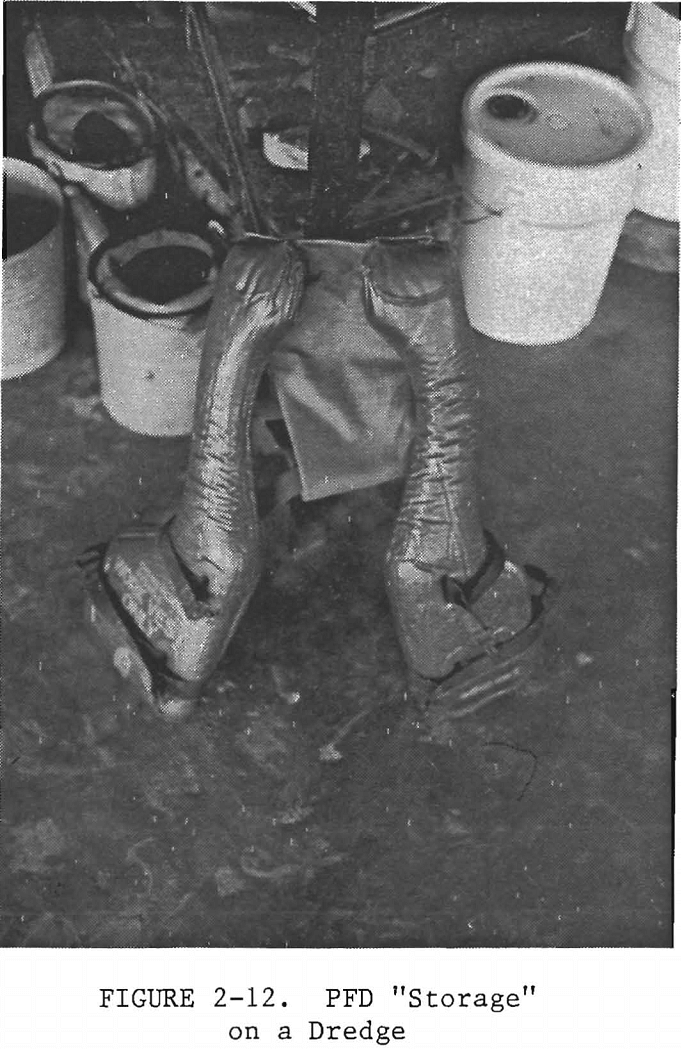
4. They were not necessary because very few people who fall into the water are hurt.
5. They are unreliable as lifesaving devices — people have drowned with their PFDs on.
6. They encourage people to be careless about avoiding falls into the water.
Objections 1, 2 and 3 have merit. Many of the PFDs provided were very old, bulky and easily soiled. Objections 4, 5 and 6 are, at best, part truths. These ideas persist because of inadequate training in water safety and poor safety management. Only one of the dredge operations visited
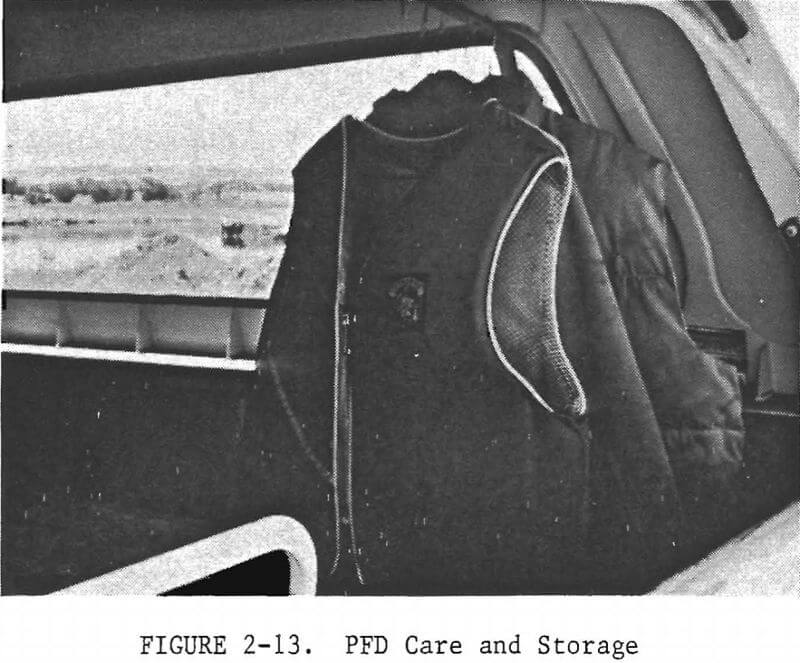
had mandatory training in water survival. Only a few required that dredge workers be able to swim, and these did not require a demonstration of that capability or a certificate from a Red Cross, or other, training program. (The ability to swim is not as important as water survival competence when fully clothed, as taught by the Navy and other organizations.)
Only six of the dredge operations visited had regular training and practice for their workers in first aid for drowning victims.
Slips and Falls on the Dredge
Every dredge has some slip and fall hazards. On some these hazards are very little more serious than those found in shore-based facilities, except during storm or icing conditions. Others have significantly greater slip and fall hazards than shore-based plants and shops. This is due, in part, to space limitations on board, but poor design and poor safety management are the principal reasons for the hazards.
Ladders and stairs are often designed with little consideration for human factors. See, for example, Figure 2-14, which shows a ladder with small round rungs, inappropriately spaced; inadequate toe space; and no
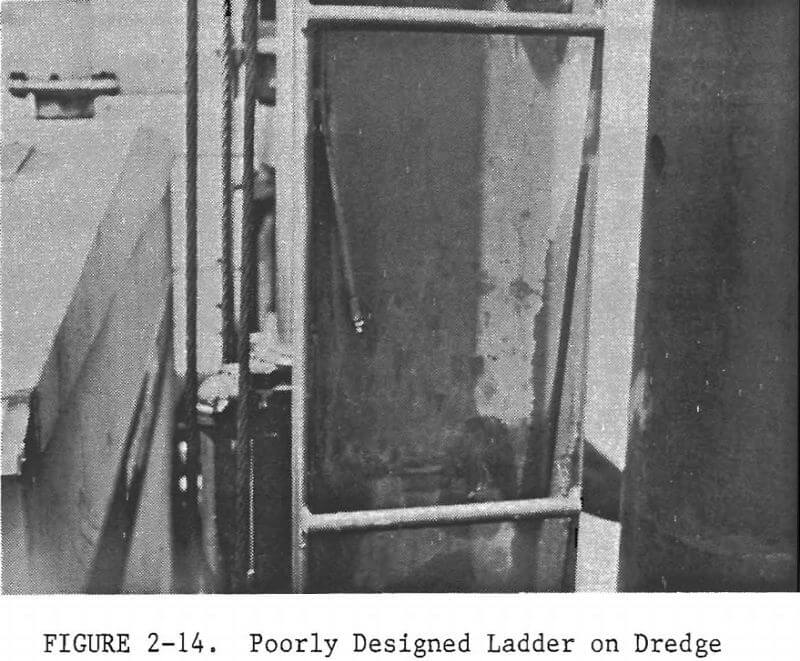
handrails. Many similar ladders observed during the field visits were installed by dredge owners as safer alternatives to portable ladders — and in many cases they are. However, a modest consideration of human factors during their planning and construction would have produced ladders which are much less hazardous.
Figure 2-15 is another type of ladder similar to many observed during the field visits. The problems in its design are obvious, particularly at the fourth step of the ladder in the foreground. Observe that the ladder once extended much lower. The steps were removed after it was installed because they created a bumping hazard for people working on the deck.
Figure 2-16 illustrates some common hazards on dredge stairs. Although, in this case, the treads are made of dimpled metal plate to reduce slipping and the step and riser dimensions are adequate, there is no handrail and a metal beam obstructs the stairwell.
Figure 2-17 shows a section of a dredge which has several tripping hazards on the deck. In this case there is no deck railing at the section, probably for convenience in moving fuel and lubricants. The hoses and metal
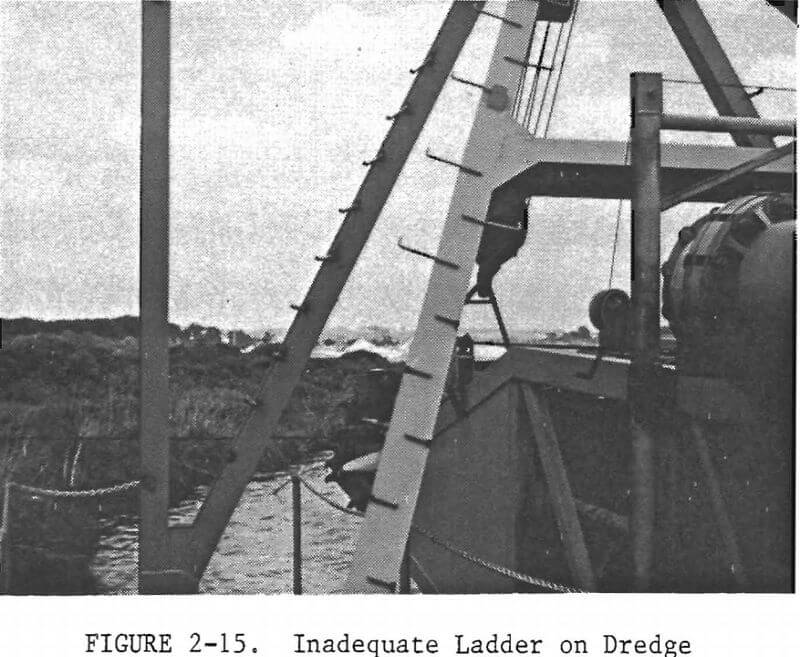
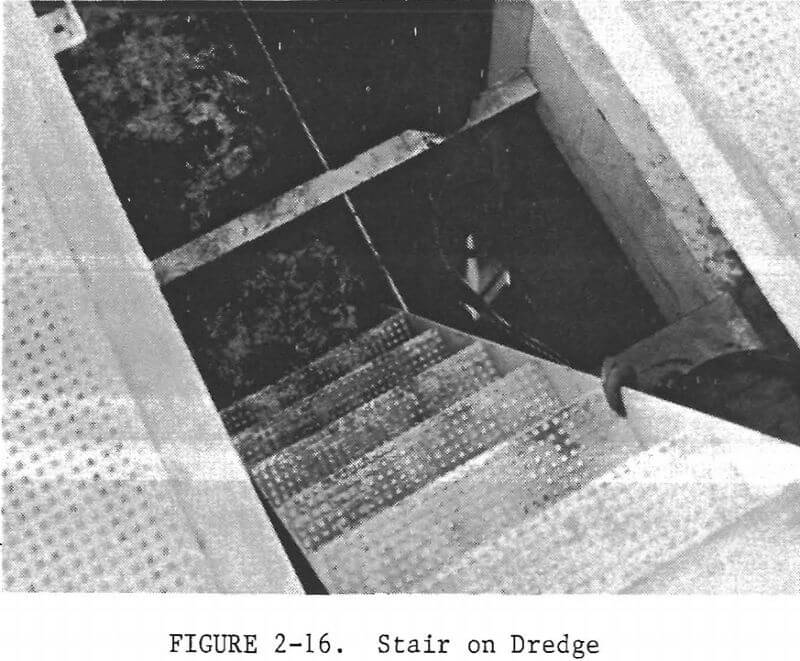
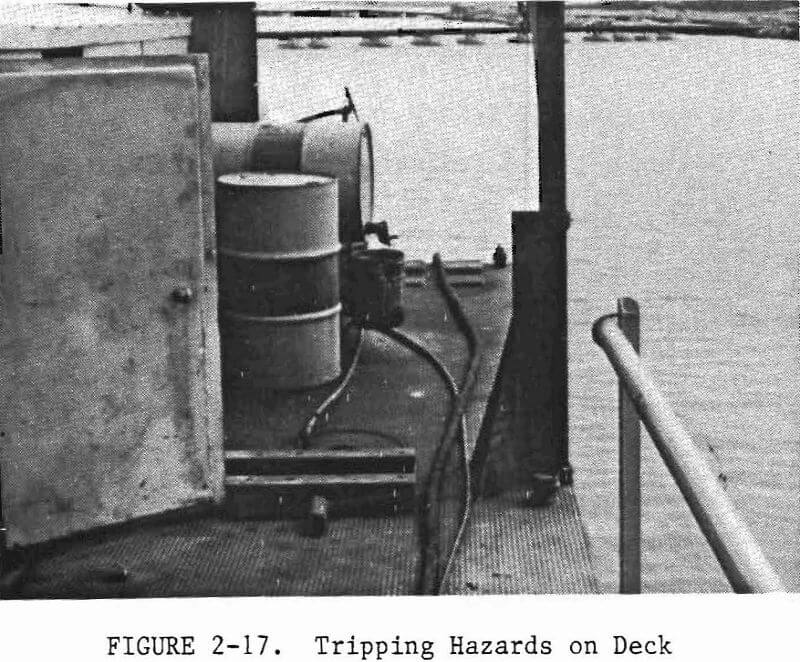
objects on the deck, which is constructed of material designed to reduce slipping, reflect poor work procedures and safety practices.
At all of the dredges visited, including those in Florida, dredge masters and other workers emphasized the “severe hazard” of slips and falls when there was ice on the decks, dredge-to-shore walkways, boats and pipelines. One of the dredges visited once had a fatal injury accident related to ice on a pipeline. At several of the dredges, workers on the deck or pipeline were required to be attached to a lifeline during icing conditions so that if they slipped off of the working surface, they could be pulled back, or would be more likely to be able to pull themselves back, to safety. None of the dredge operations knew of a deck surface, or a method of clearing deck ice, that was considered satisfactory.
Many of the dredges have done nothing to reduce the slip and fall hazard on deck except to provide “grab irons” or railings. Many of the decks were of smooth steel plate which was always slippery unless it was completely dry.
Diesel-powered dredges were often observed to have fuel and oil deposits on walking surfaces, greatly increasing the slip and fall hazard.
With one exception only, the management of every dredge visited stated that slips and falls were the greatest safety problem.
Electrical Hazards
Most of the dredge operations visited had some type of electrical power line from shore to dredge. The voltage ranged from 4,200 volts down to 110 volt lines for lighting only.
The observed high voltage lines which provided power to the dredges were well protected, properly installed, and adequately maintained. Some type of ground fault indicator was installed at most electric-powered dredges.
The greatest dangers observed related to power lines for lights and auxiliary equipment. Incorrect splices, poor insulation, unsafe suspension and “dry” connections subject to immersion were observed. There were several instances of failure to use insulating bushings at entries to junction boxes or penetrations of bulkheads.
Figure 2-18 shows an electrical line routed around a pipeline and its fittings dropping into the water. The insulation on the line could easily be abraded by the objects over which the line passes. This picture is evidence of very careless handling of electricity.
Figure 2-19 shows the installation of an electrical cabinet on a dredge. The cabinet is carelessly attached to the upright and lines are placed so that damage to them is easily possible.
Figure 2-20 illustrates a common condition. Electrical lines are poorly suspended (especially as seen on the right side of the picture) and allowed to “droop” into the water.
It was clear that the majority of the electrical hazards observed were the results of inadequate training of workers who handle electrical lines and poor safety management.
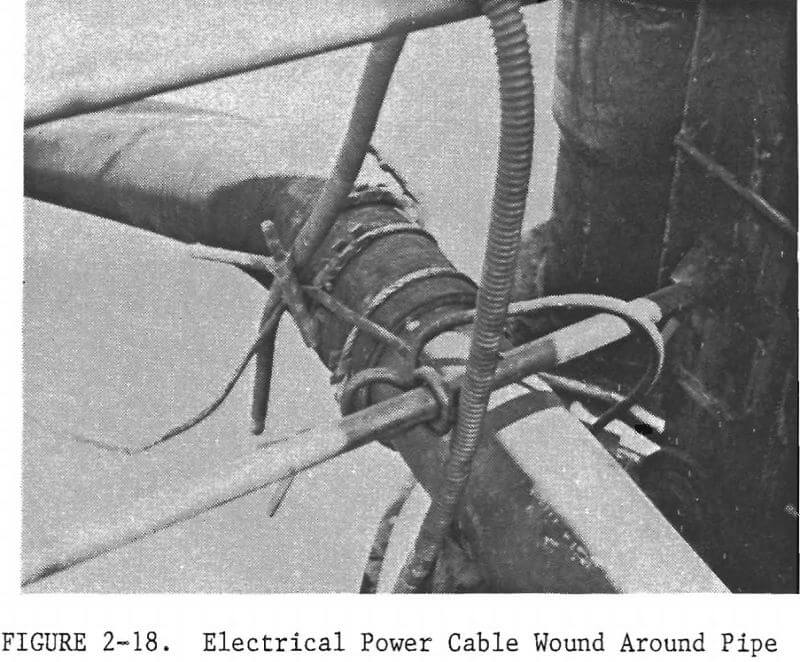
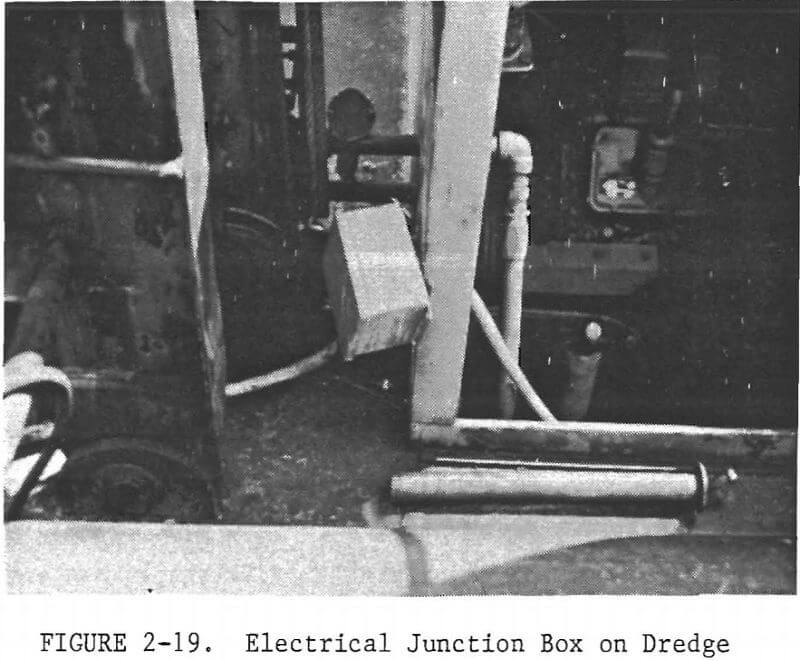
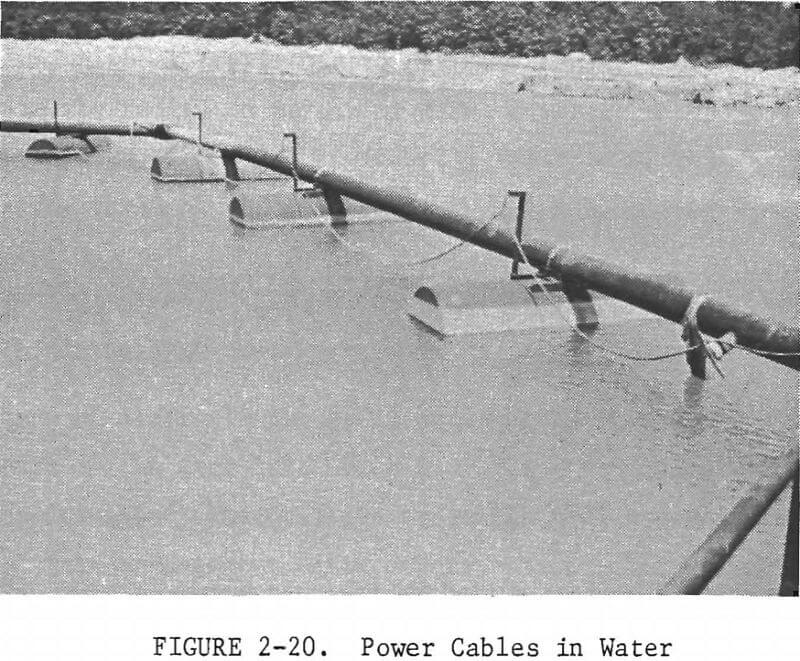
Other electrical hazards related to dredge operation which were mentioned by safety authorities, but not specifically observed during the field visits, include:
- Inadequate substation grounding.
- Inadequate lighting protection. (This condition was observed on some of the smaller dredges visited but, according to their operating policy statements, they stopped operation and pulled into the shore when there was “threatening weather” in the vicinity.)
- Lack of ground fault tripping devices.
- Lack of, or inadequate, equipment/frame grounding.
- Lack of overcurrent protection.
- Failure to “lock out” electrical power during maintenance and repair work. (This condition was observed only once during the field visits. The explanation given was related to the manufacturer’s comment noted on page 5-3, lines 6-10.)
A more detailed analysis of electrical hazards in metal and nonmetal mining, including those applicable to dredges, and appropriate counter-measures is in the report on Bureau of Mines Contract No. J0308025. That work was done by the Electrical Engineering Department, West Virginia University. The title of the program is “Develop Grounding Practices for Metal/Non-Metal Mines.”
Mechanical Hazards
One type of clamshell dredge is constructed from a barge with a lowered section on the deck into which a dragline is placed with just enough space for the crawlers. The dragline house can then rotate across portions of the deck. This arrangement often creates pinch point hazards between the house or boom and deck structures such as winches, spud supports, or railings when the dredge is operating. An additional pinch point exists between the bottom of the house and the deck during maintenance which requires house movement. The hazard can be seen in Figure 2-21. (Note also in Figure 2-21 the tripping hazards on decks.) On some dredges the
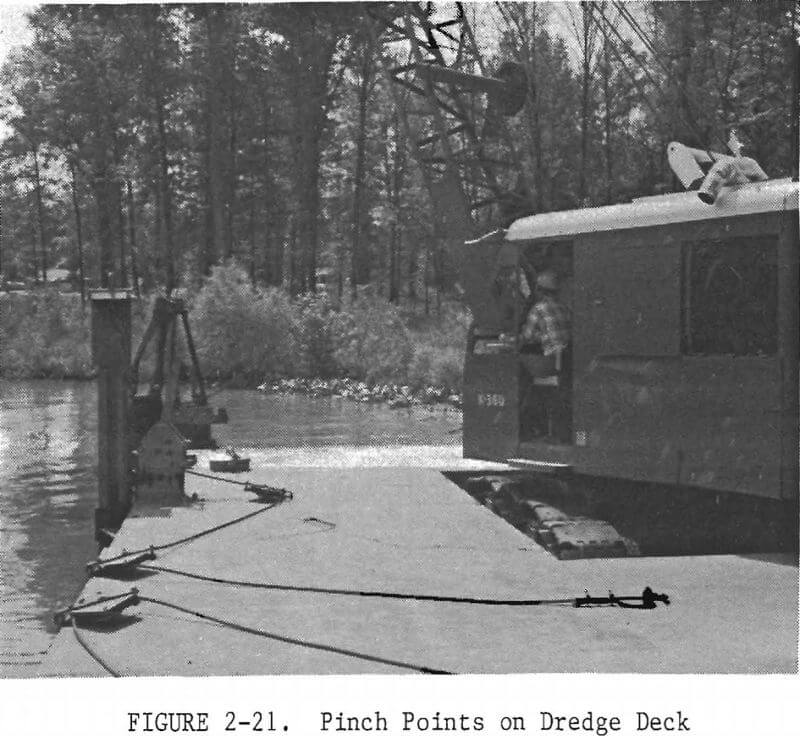
hazard is dramatically evident. On one, for example, the spud supports had been “notched” to provide the necessary clearance for the rotating house. But the clearance is often so little that an arm could easily be amputated or a body severed if caught between the stationary structures and the rotating house or boom.
A different kind of pinch point which was observed and often discussed occurs at pipe unions when pipe sections are being connected. Usually the pipe sections are attached to buoys and floated into position for joining. The final alignment is done by the workers who connect the union. As the sections come together there is a danger of pinching hands (and feet), especially if the water is not perfectly calm. This hazard was cited by many dredge workers. The frequency of the hazard depends upon the nature of the dredging operation, that is, how frequently the dredge is moved or the pipeline lengthened. Figure 2-22 shows a pipeline connection point, between the two buoys. Generally, the larger the pipeline the greater the alignment and connection difficulty and the associated hazard.
“Cables” or “lines” of wire rope are used on most dredges for positioning, for raising the digging ladder, for anchor connections or for
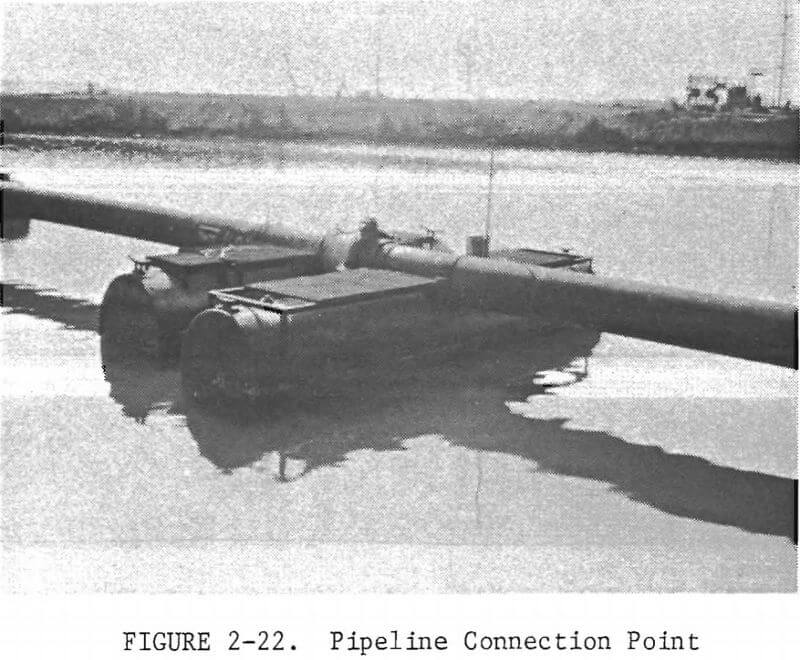
various kinds of hoisting. The primary hazard in the handling of wire rope occurs when the rope has broken strands which produce “fishhooks” along the rope. Hand injuries may easily happen if proper precautions are not taken. All of the dredge operations visited used wire rope and all had a procedure for inspecting it periodically. Most required the use of special equipment, such as heavy gloves or rope handling tools, when the rope was replaced or inspected.
Another hazard is related to the routing of the wire rope on the dredge. The control of the rope’s function requires drums and sheaves. These are frequently unguarded, making it easily possible for a tool, a garment or a hand to be caught between the rope and its control mechanism. An example of an inadequately guarded rope is shown in Figure 2-23. There is a guard over a straight section of the rope (on the left in the picture) but none over the sheaves.
A wire rope hazard which can produce very serious injuries occurs when the rope is subjected to high tension loading. Under this condition the rope is like a very large spring with a lot of stored energy. If loaded
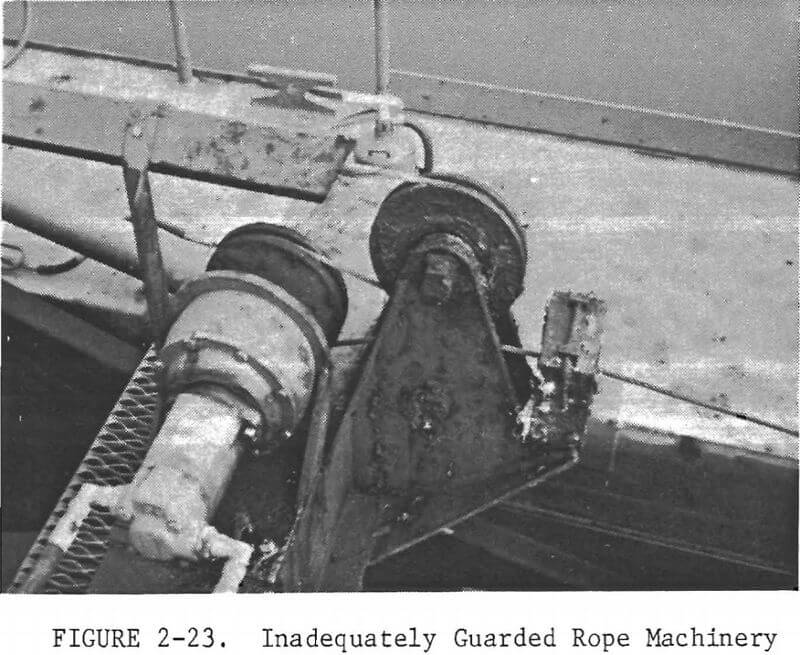
beyond its rated capacity, it can break and whip back in both directions. A. rope used as a shore line, and broken by overloading, is shown in Figure 2-24. During the field visits a rope broke at a dredging operation and one end whipped back to the control house, breaking the windshield and a side window. The dredge master believed that had he been in the control house, or on the deck adjacent to it when the rope broke, he surely would have been injured, perhaps very severely.
On the smaller, newer dredges, the rope drums for digging ladder control, or positioning, are often immediately in front of the control house and unguarded. An example is shown in Figure 2-25. The probability of catching tools, garments or hands in the moving ropes and drums in this location is low. But, if a rope breaks under tension at a point several feet ahead of the drums, a whipping end may damage electrical cables, cut hydraulic lines and break glass, in addition to injuring people directly.
Some dredges of the clamshell type have a grizzly or screen aboard to prevent large rocks, roots and other unwanted material from entering the dredge-to-shore conveying system. Two kinds of hazards related to these sorting devices were observed. When workers attempt to remove “foreign objects” stuck on a moving screen, the risk of injury to hands is high. It was observed that “screen cleaning” of this kind was done routinely without shutting down the product flow and stopping the vibrating device which moves the screen. The second hazard is of a different nature. If a grizzly is used, it is on top of a feed hopper into which the clamshell dumps. The grizzly is thus much higher than the deck. When it becomes necessary to remove large objects from the grizzly fed by a nonrotating clamshell, the digging operation is halted and workers ascend to the grizzly to remove objects manually. They are often not able to throw the objects overboard, so the objects are dropped to the deck. Unless precautions are taken, and sometimes even If they are, there is a falling object danger to workers and t0 equipment at the deck level. Rotating clamshells usually attempt to remove objects from the grizzly with the clamshell itself, occasionally producing the same falling object danger as the manual removal creates.
At several of the dredge operations visited the personnel boats, or Work boats, were powered by an outboard motor which was started manually
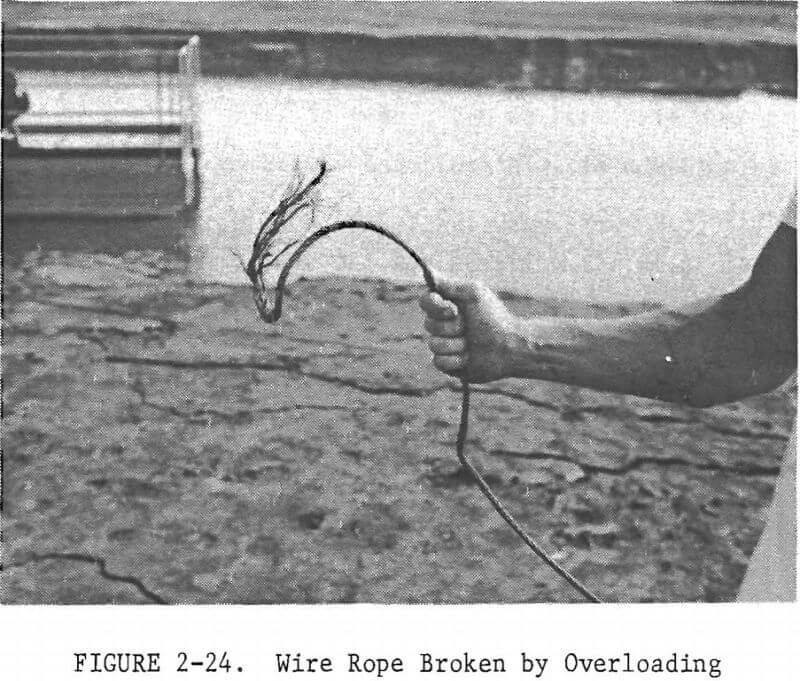
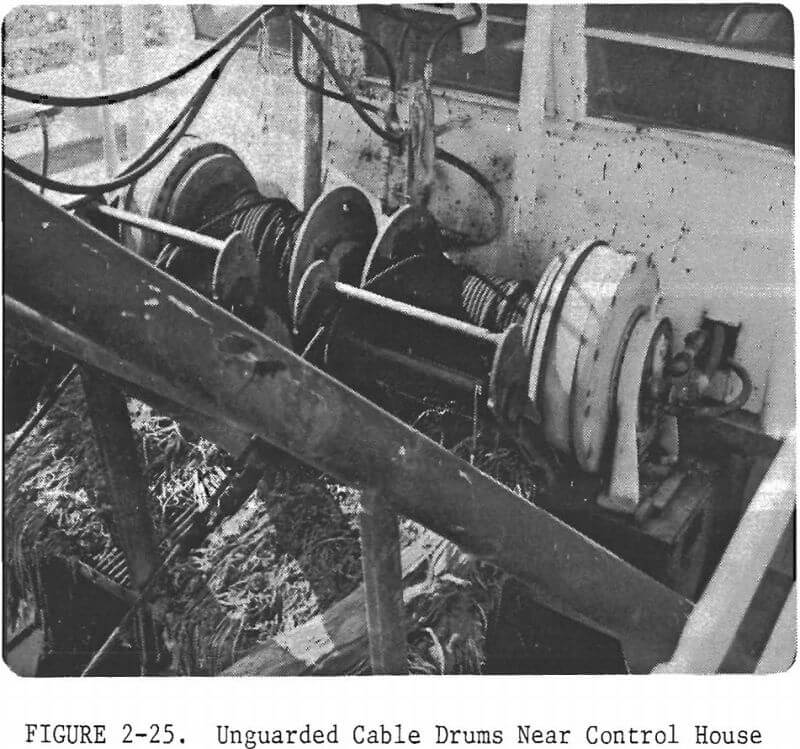
(with a pull rope). It was reported that a serious safety problem was created because workers would “lock out” the safety device on the gearbox so that the motor could be started while in gear. The workers said that starting was thus made “easier and quicker.” Unfortunately, in addition to the danger of poor directional control of the boat when the motor was started, there had been cases in which the worker who was starting the motor lost his balance and fell into the boat, onto the motor or into the water.
On some of the dredges observed the water pressure at the pump outlet was in the range of 100 to 250 pounds per square inch. Leaks in the pipe, or joints, can produce relatively high pressure water jets. These jets represent a hazard both in terms of inflicting injury directly or of causing a worker to fall overboard or into moving machinery. A high pressure water leak was a principal contributing factor in one known fatal accident. In a phosphate slurry pumping operation, a gasket failed and the resulting water jet forced a worker backward into moving machinery.
Moving machinery is always a hazard, but the risk of accidental injury can be greatly reduced by proper guarding and proper work procedures. Many of the dredges visited had inadequate guarding of some of their moving machinery. Figure 2-26 shows the machinery guarding on one of the smallest dredges visited. The dredge is certainly not typical of all mining dredges, or even of the small “shop built” dredges, but the picture serves to emphasize the type of hazard that is common. (Note also in the picture the lack of deck and stair railings.)
Even if moving machinery is well guarded, poor work practices can defeat the safe condition which guarding is designed to provide. It was observed that guards were removed during machinery maintenance and not properly replaced and that some workers dressed belts, lubricated pulley bearings, and removed material from between the conveyor belt and pulley by maneuvering around, between or under the guards while the machinery was moving.
Clearly worker training and work discipline are the key problems. There are very few engineering solutions to safety problems which cannot defeated by unsafe acts. Pitching dredge decks make unsafe acts even more dangerous than they would be on shore facilities.
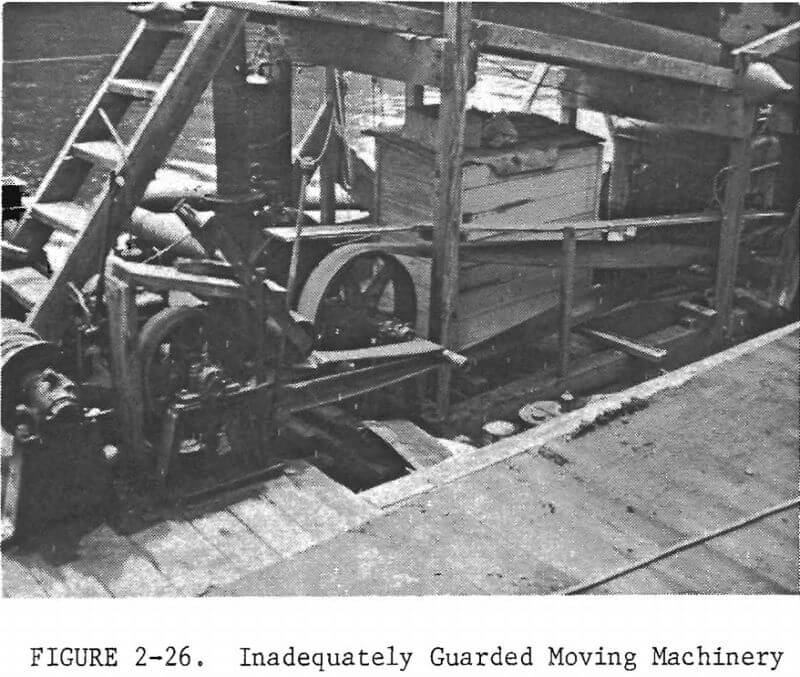
Fire
Fire is not a frequent occurrence on dredges. However, as with any boat or ship operation, on-board dredge fires can have very serious consequences. It appears that dredge fires can be characterized as follows (in approximately the order of their frequency):
- Fire started when fuel or hydraulic fluid leaks contact exhaust manifolds or other very hot engine parts.
- Electrical fires.
- Engine room fires involving oil accumulation on the floor or the engine.
- Fires resulting from flammable debris left near engines or in areas where welding is being done.
- Fires started during fuel transfer and refueling operations.
Figure 2-27 illustrates inappropriate storage of flammable material near an tuition source. In this case, buckets were provided for disposal of
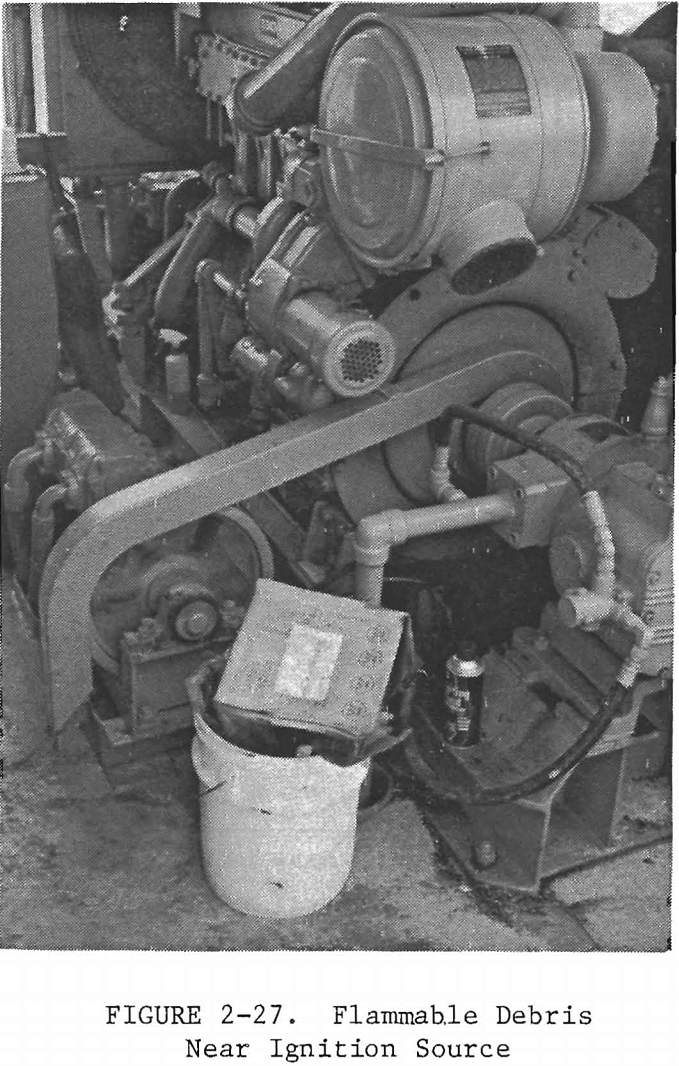
oil-impregnated rags. One such bucket was filled to overflowing with rags and oil-soaked cardboard containers and was left in the location shown.
Of the diesel-powered dredges visited, all except one used some form of manual fuel transfer from shore to dredge. One operation had a fuel barge with which to transfer full barrels to the dredge. Many of the smaller dredges employed a work boat and a 55-gallon fuel drum for the refueling tank. A more or less typical arrangement is that shown in Figure 2-28. There is frequent fuel spillage on the dredge and in the work boats. Few fires result, but the risk of fire is relatively high and the risk of injury in the event of fire even higher.
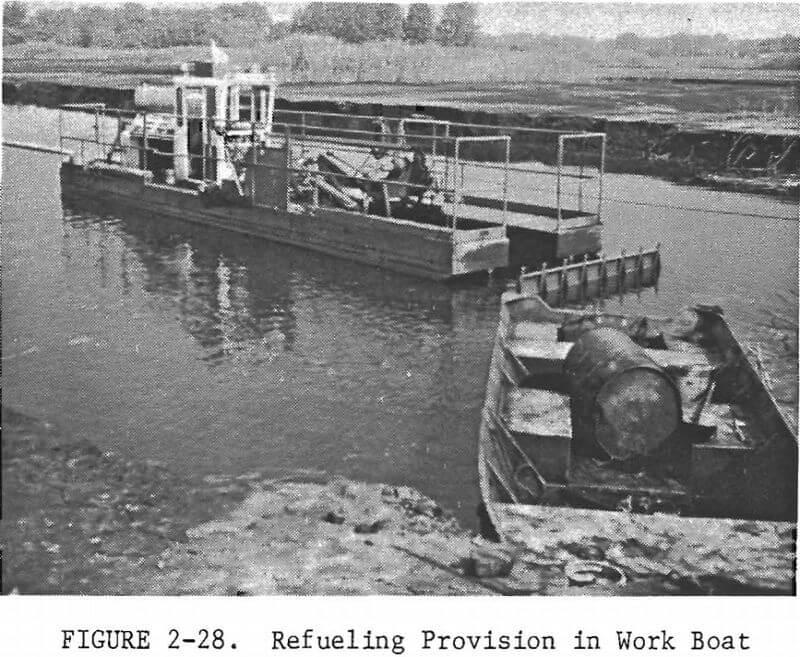
Generally, the engine compartments on the dredges visited were clean and the floors free of oil, but at least two were “disaster areas.”
The welding tasks observed were done with appropriate preparation of the area, including removal of flammable material. However, there were several fires reported by persons interviewed in which careless welding practice had been the principal contributing factor.
An engineer at one of the dredge manufacturers visited described in some detail a serious dredge fire in Mexico. It began when a hydraulic line broke and hydraulic fluid was sprayed onto the engine exhaust manifold. Several other like fires were discussed during the field visit.
As with other hazards, accident countermeasure development should be, first, to prevent the accident and, second to reduce the severity of the consequences should an accident occur. In terms of the fire hazard, the primary consideration should be fire prevention, but fire suppression must not be neglected. Oil and fuel fires are difficult to extinguish. Some of the dredges did not have effective extinguishing capabilities for such fires. Several who did have said that they would use the dry chemicals “only as a last resort” because of “the mess the chemicals make.” Only two of the dredge operations visited had regular fire drills.
Hazards on Shore
The majority of the dredging operations observed had one or more mobile machines on shore to support the dredges. Usually these were tractors, loaders or cranes, sometimes with special attachments for handling pipe. The hazards were identical to those in any kind of mining in which machines of these types are used, but with one rather important addition: the terrain on which the machines work is generally not as well prepared. The shore earth construction, except for dikes and waste dumps, was often the minimum necessary for the tasks to be performed over a short period of time. Consequently, the mobile machines work over partially cleared, undulating terrain where the risk of rollover accidents appears to be higher than normal for surface mining operations. Nearly all of the mobile machines observed had a rollover protection structure and a seat safety belt installed. However, very few operators were wearing the seat belts provided.
Many of the mining dredges have some type of product cleaning and sorting capability on shore. The cleaning of screens is done in the same way as it is done on board dredges. The same dangers are present.
In pioneering operations where ground must be cleared ahead of the dredge pond, dozers and loaders are operated in trees and heavy brush. Limbs often snap into the cab, breaking windshields and sometimes injuring the operator. Two of the dredge operations observed had installed “limb sweeps,” similar to those used in orchards and in logging operations, to reduce the hazard.
On-shore belt conveyor sections are commonly unguarded. The usual moving machinery hazards exist.
At several sand and gravel dredging operations, on-shore workers stated that one of their major safety concerns was eye injury or temporary impaired vision because of blowing sand and dust. No “outside” worker was seen wearing safety goggles except those engaged in maintenance and welding tasks.
Other Hazards
There were several hazards observed, or brought to the attention of the field survey team by others, which apply to only a small proportion of the total mining dredge fleet or to infrequent operating conditions.
Among the phosphate mining operations visited in the Southeast there were three silt dredging operations at which hydrogen sulfide gas was a significant hazard. H2S is a colorless, inflammable gas which has an offensive odor. The gas is sometimes liberated from “pockets” during dredging. At locations where this phenomenon occurs, or might occur, the dredges are equipped with H2S monitors to detect the presence of the gas. Workers interviewed expressed concern about the dangers of H2S and most believed that they would smell it and take precautions before the monitors could warn them of the danger.
Their belief may, or may not, be correct. Safety may depend upon the H2S monitors. References dealing with the characteristics of industrial health hazards note that the odor of H2S, similar to the odor of rotten eggs, can hardly go unnoticed. However, it may seem to have disappeared when in fact it has not because H2S acts to fatigue the olfactory nerve. Dangerous effects, including collapse and unconsciousness, may occur with very little warning.
PCB was identified as a dredge worker health hazard during a visit to an MSHA Metal and Nonmetal Subdistrict office. It was stated by MSHA inspectors that the capacitors used for power factor regulation on some electrical-powered dredges contain large amounts of PCB. If a leak develops in a capacitor, the PCB will seep into the bilges, creating a health hazard for dredge workers who do cleaning or other tasks in those areas.
Noise is a health problem, as well as a safety problem (restricting effective communication), on some diesel-powered dredges which have not taken sound suppression measures, active or passive. Very few hearing protection devices were seen during the dredge visits.
Ice on the dredge pond increases the danger of falls into the water. Three dredge operations required the workers to use lifelines during deck work when the pond was covered with ice. Workers who fall into the ponds may go under the ice. The lifelines provide the best means of self rescue or of aided rescue.
Recommended Bureau of Mines Research
One of the requirements of the contract was to develop a list of recommended research projects which would produce improvements in safety at dredge mining operations. This section defines the recommended projects, all of which reflect the principal hazards identified in Section 2.0.
Summary of Safety Improvement Methods
The primary need with respect to improving safety in dredge mining is information. Very few of the dredge operations visited had knowledge of, for example, the American National Standard: Safety Requirements for Dredging or the several dredge-related publications of the National Safety Council or even of the small numbers of 30 CFR standards pertinent to dredging. Those few who knew about the standards often did not understand some of the safety and loss control benefits conformance would produce. The documents do not provide examples of what can occur, or has occurred, in the absence of the safeguards. They do not indicate by illustration how some of the standards can be applied in simple, low cost ways.
In the dredging industry there is not an organization of dredge owners, or of manufacturers, which devotes its attention to the safety interests of the membership. Unlike, for example, the American Mining Congress, organizations such as the Western Dredging Association and the World Dredging Association do not have “safety sections.” (Indeed, until 1980 they did not have papers related to safety included in the presentations at their four-day conferences. A paper on this Bureau of Mines program was a first.) Furthermore, the World Dredging Association is concerned primarily with large dredging construction projects, with harbor and channel maintenance, and with very large-scale mining. Little attention is paid to the types and sizes of dredges which represent most of the more than 800 engaged in mining in the United States. There is no division of the National Safety Council specifically and regularly concerned with dredging safety. In short, the institutional arrangements which develop and disseminate safety information for other kinds of mining do not exist for dredge mining. Thus, to improve safety in dredge mining there must be information mechanisms created and supported.
The second need is for safety equipment development and field demonstration. Little attention has been paid in the past to such equipment specifically for the particular needs of dredge workers.
The third need is for safety training programs and aids designed with the special needs and organizational characteristics of mining dredge operations in mind. There are a few excellent dredge safety training aids presently available through MSHA or private companies (see other sections of this report), but additional materials which deal with safety areas not now covered in detail would be helpful to the industry. New formats, designed more for individual on-the-job instruction, rather than classroom instruction, should be developed.
The projects identified in the subsections below are listed in the order in which their initiation is recommended.
Development Of Improved Personal Flotation Devices (PFD)
There are federal standards concerning the use of “life jackets or belts.” Those applicable to surface metal and nonmetal mines; sand, gravel and crushed stone operations; and surface coal mines are reproduced below from Title 30 CFR:
55.15-20 Mandatory. Life jackets or belts shall be worn where there is danger from falling into water.
56.15-20 Mandatory. Life Jackets or belts shall be worn where there is danger from falling into water.
5 77.1710 Protective clothing; requirements.
Each employee working in a surface coal mine or in the surface work areas of an underground coal mine shall be required to wear protective clothing and devices as indicated below:
(h) Liiejackets or belts where there is danger from falling into water.
However, it is clear that the requirement is seldom enforced in many dredge operations, except possibly when the MSHA inspector or the insurer’s representative is on the property. The reason is equally clear: many workers regard the available PFDs as uncomfortable, inconvenient, and even hazardous, to use regularly. A new design (or designs), which provides a comfortable, convenient PFD which does not interfere with work, and which is unlikely to “catch” on anything to cause a slip or fall, is needed.
A program to create the new design should be organized in cooperation with the U.S. Coast Guard’s Office of Boating Safety and Office of Merchant Marine Safety; with the U.S. Navy and with manufacturers of personal flotation devices.
In addition to the operational considerations mentioned above, the improved PFD design should incorporate:
- “Type I” or “Type II” capability to turn unconscious persons in the water to a vertical and slightly backward position, and to maintain them in that position.
- Optional hypothermia protection.
- Covering material that is stain resistant and easy to clean.
- Provisions for a small emergency light similar to that required for PFDs on commercial vessels by 46 CFR 25.25-13 and an emergency sound signal.
The development program should include training programs and materials, not only about proper use of the improved PFD, the treatment of drowning victims and hypothermia, but also about water survival techniques (for example, how to float and to conserve energy).
Handbook for Dredge Safety
The Bureau of Mines should create an authoritative “Handbook for Dredge Safety.” A project for this purpose is outlined in the paragraphs below, by task.
The project should be of approximately nine months duration, plus handbook printing and distribution time.
Task 1: Reference Data Collection and Review
Reference material from authoritative sources should be collected, collated, reviewed and rewritten in suitable form for the handbook. Needed pictures or illustrations should be identified, or permission sought to reproduce tables and illustrations from existing publications. Material may be obtained from government agencies (OSHA, MSHA, USCG and USN, for example); from private safety and standards organizations (NSC and ANSI, for example); from some dredge operating companies and dredge manufacturers; and from equipment and component manufacturers (diesel engine, hydraulic drive, wire rope, tread, pipe and conveyor manufacturers, for example).
At least four field trips should be planned to collect and discuss key information elements.
This task should take approximately three months.
Task 2: Draft Handbook
A draft of the handbook should be prepared for field review and coordination. It should be formatted for a planned 6-inch by 9-inch final publication, but copied on standard 8½ inch by 11 inch paper with margins adequate for correction and change notes. Approximately 20 copies should be made for field review by mail and visits.
Two months should be adequate for this task.
Task 3: Field Review
Coordination of the material with selected firms and agencies should be accomplished by mail and field visits. Six field trips should be planned for this purpose. The objective is to verify the correctness of the material in the handbook and to obtain editorial criticisms. In addition to review by the Bureau of Mines, there should be coordination with at least the following:
- MSHA (Technical Support and Metal/Nonmetal)
- Dravo Corporation
- Texasgulf Corporation
- Ellicott Machine Corporation
- Dredge Masters International
- Mobile Pre-Mix Company
- West Virginia University, Department of Electrical Engineering
- U.S. Army Corps of Engineers
- International Union of Operating Engineers
- U.S. Navy
- National Safety Council
- U.S. Coast Guard
- Western Dredging Association
- OSHA
- Associated General Contractors of America
- National Sand and Gravel Association
Two months should be planned for this task.
Task 4: Preparation of Final Handbook and Review by the Bureau
Following the field reviews, the handbook should be corrected and changed as appropriate and prepared in “camera-ready” form for publication. The Bureau should conduct a final pre-publication review.
One month is appropriate for this task.
Task 5: Publication and Distribution
The handbook should be published, preferable in loose-leaf form, in approximately 1,000 copies. Distribution should be made to every mining dredge operation in the United States, using the MSHA active mine operations listings; to the MSHA Training Centers; to every MSHA district and subdistrict (coal and metal/nonmetal) in which there are dredge mining operations; to dredge manufacturers; and to others who have an interest in dredge safety.
Distribution should commence immediately after the seminars discussed in Subsection 3.5 below.
The recommended content of the “Handbook for Dredge Safety” is defined the following outline of sections.
I. Introduction — Purpose of handbook; recommendations for use; organization of contents.
II. Safe Dredge Operation Procedures
A. Water Safety and Nautical Requirements
- Use and care of PFD. How, where, and when
- Training in water survival
- Boat operation and rules of waterway
- Seamanship
- Use of floating walkways
B. Communications
1. Signals for change in operations or task requirements
2. Normal communications with shore, plant, or office
3. Emergency communications, dredge to shore, shore and dredge to water
4. “Buddy system” and procedures to account for worker location and status
C. Emergency Procedures and Equipment
- Rescue access to dredge (boat availability and pipeline)
- Fire fighting
- Lifesaving techniques
D. Regulatory Requirements, Organized Standards and Recommendations on Ways to Comply
- 30 CFR provisions relating to dredging
- ANSI A10.15
- Corps of Engineers General Safety Requirements
- Others
III. Design, Construction and Maintenance For Dredge Safety
A. Walkways and Ladders
- Size and location of access paths
- Materials and assembly
- Painting and marking for hazard recognition
- Maintenance and repair of structures
B. Decks and Work Areas
- Nonskid surface materials and application techniques
- Lighting requirements and placement of lights
- Painting and marking for hazard recognition and improved visibility
- Storage locker design and construction (oil drums, ropes, etc.)
C. Machinery Guards and Covers
- Designs for rotating shafts, bolts, chains, mechanisms, winches, etc.
- Construction techniques and materials
- Painting and marking for hazard recognition
D. Cables and Winches
- Cable maintenance and inspection
- Splicing and repair of cables
- Winch alignment and lubrication
- Winch relief setting for maximum loads
E. Hydraulic and Electrical Controls and Distribution Systems
- Inspection of pipes, conduits, switching gear, pumps, etc.
- Safe maintenance practice (lockouts, pressure checks, signals, signs, etc.)
- Human factors considerations in the location, motion, and shape of controls and seats
- Ground fault indicators and electrical system maintenance
F. Fuel and Material Handling
- Grounding and fuel line insulation to prevent arcing
- Lifting and rigging materials for loading onto boats or dredges
- Storage of fuels and lubricating oils
G. Pipelines and Umbilical Connections
- Design of alignment aids for connecting pipe
- Connectors available and specifications
- Float design and construction
- Splicing umbilicals and hanger construction
IV. Dredge Crew Operation and Maintenance Training
A. Safe Work Practices Development
B. Structured On-the-Job Training
C. Programmed Instruction
D. Knowledge and Skill Evaluations
V. List of Representative Materials Suppliers
A. Nonskid Materials and Paints
B. Ladders and Cages
C. Pipe Connectors
D. Personal Flotation Devices
E. Emergency Medical and Communication Devices
F. Training Aids
G. Other
VI. Bibliography and Additional References
Materials and Designs to Reduce Slips and Falls
A research and field evaluation program related to slip-reducing materials for decks and other work surfaces and to fixed ladder and stair design should produce information of value to dredge manufacturers and owners. The Bureau should organize such a program. The emphasis should be on the needs of mining dredges, but the program should include consideration of work surfaces on mobile mining machines, ore processing plants and mills.
Many mining dredges are “shop built” or modified extensively from their original configurations. Little attention is paid to the techniques of slip reduction on working surfaces. Part of the reason is reluctance to invest in materials for which solid performance information for dredge operating conditions is not available. The program recommended would evaluate available surfacing materials from manufacturer’s data; select for field evaluation those which appear to be the best, considering cost as well as performance; and evaluate in the field, with the cooperation of dredge owners, the actual performance over an extended period (at least two full “operating seasons”). The kinds of footwear soles which provide the best footing on the surfaces being evaluated should be determined by test during the evaluation.
The part of the program dealing with ladders and stairs would not be a human factors examination of ladder and stair design because such information is already available from many sources. It would concentrate instead upon component selection and construction (ladder rungs, stair treads, durable nonmetal handrails, etc.) The best of readily available components and construction methods, considering both cost and performance, would be used to fabricate test ladders and stairs for field evaluations at the same sites, and during the same time, as the surfacing materials evaluation.
Participation of dredge manufacturers in the program should be sought, but the field evaluation should not be done through them. A primary goal of the evaluation is maximum objectivity with respect to safety performance.
Dredge Mining Safety Conferences
Upon completion of the handbook program discussed in Subsection 3.3, the Bureau of Mines should sponsor a series of dredge mining safety conferences. The conferences should be organized in the same way as the Bureau’s technology transfer seminars. The objective is to stimulate interest by dredge owners in the handbook and in its use in improving their safety programs. It would be desirable to have four conferences in different regions of the United States. Nebraska should be the state in which one is held because it has many more mining dredges (mostly sand and gravel) than any other state.
The agenda of the conference should follow in a general way the contents of the handbook. The handbook itself should be given to each person who attends.
The conferences should be held during the mid-winter months.
Dredge Mining Research Information Office
The Bureau of Mines should consider establishing, as an in-house activity or through a contract arrangement, a Dredge Mining Research Information Office. The functions of the office would be three:
- Collect and distribute information useful to the dredge mining industry, primarily, but not exclusively, that information which relates to safety and loss control management. Included would be information developed from the projects recommended in Subsections 3.2 and 3.4, distributed in a form compatible with the format of the handbook and for inclusion therein
- Work with the Western Dredging Association, the National Safety Council, dredge manufacturers, dredge fleet owners, and others to establish and support a private organization, or an element of an existing organization, for the purpose of increasing interest in dredge safety and facilitating exchanges of safety information,
- Provide advice on the solution of dredge safety problems and assistance in establishing and evaluating model safety and health programs in dredging operations.
